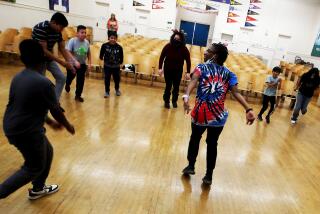Music Cuts in Schools a Sad Note : Arts-related programs would be hit particularly hard when the county’s public schools begin slashing their budgets because of drastically reduced state funding.
Susan Mares is one of those bright, outgoing teens whose flashing eyes, disarming grin and speed-of-light mind seem tailor-made for the cover of High Achiever magazine.
She’s a senior whose grades have won her acceptance to USC, UCLA, UC Irvine, UC Berkeley and a fistful of other universities, but the real love of her school life is music. She plays flute, piccolo and oboe at Saddleback High in Santa Ana and has done a fair amount of thinking about a professional career.
Sitting in the audience while professional orchestras play, “I’ve imagined myself up there,” she says, “and thought, ‘I could do that if I practice more.’ All it takes is practice.” She isn’t sure what she’ll major in at college, but she knows that whatever she ends up doing, she’ll continue to play music because “it’s become an integral part of my life.”
Given the dismal financial prospects suddenly facing music and other arts programs in local school districts, Susan and her classmates one day may be seen as the last of the lucky ones--lucky to have made that musical connection in public school.
With an estimated $10-billion shortfall looming in the state budget, Gov. Pete Wilson wants to take $2 billion from the state’s schools, and local school districts are, in turn, being forced into slash-and-burn cost cutting. Santa Ana has announced some of the most drastic cuts in Orange County: If the governor’s plan is approved by the legislature, it’s going to mean $14.2 million worth of pink-slipped teachers, cut classes and reduced supplies in Santa Ana schools alone, according to a district spokeswoman.
No one’s expecting any last-minute miracle reprieves, and virtually no department or discipline will be spared. But music and arts programs--favorite targets of budget cutters--will be particularly hard hit. Roughly half of the district’s 44 music teachers already have been told they’ll be let go, or reassigned to teach classes other than music, according to Randy Coleman, the district coordinator of music programs.
Most distressing, Coleman says, is that elementary school teachers are expected to “bump” junior and senior high school teachers with less seniority, leaving practically no one to forge musical connections with youngsters in their more formative years, in effect cutting down the tree of musical experience at its roots.
Nearly $800,000 is slated to be cut from elementary music programs in Santa Ana--that’s roughly two-thirds of the budget, and it means displacing 16 of 22 elementary teachers. The district’s athletics budget, by comparison, will be cut at the secondary level to the tune of $400,000, or 25%. The administrative budget will be cut by $437,000, or 6%.
Susan Mares knows what the situation is, and even though she’ll graduate soon, she’s worried. Because she knows that, as well as she’s done in her other classes, music is what has made school something to look forward to.
“A lot of people grumble about getting up early to go to band practice and having to march around in the freezing cold every morning,” she says. “But when you get down to it, when you go to a competition and know you did a good job--regardless of what the judges say--you feel you’ve accomplished something. It really makes it all worthwhile.”
What will happen to these students when music programs are reduced, or eliminated altogether?
Enter John Benham, a music consultant from Shoreview, Minn., outside St. Paul. Benham is popular on the music educators speaking circuit for his advocacy of public school music programs. He spoke to the National Assn. of Music Merchants convention in Anaheim in January and will be giving a series of seminars this week to California music educators, who’ll be there to pick up specific advice on how to keep music classes away from the budgetary guillotine.
“Consider,” Benham said on the phone from his home recently, “when you cancel a band class that usually has 50 to 60 students--or a choir or an orchestra--what class do they go to? They’ll have to go to math, science and English classes of 25 to 30 students. So for every band you cancel, you have to open two other classes. It’s totally counterproductive.”
Sure, Benham--who speaks Wednesday in San Diego and Friday in Los Angeles as part of a brief swing along the West Coast--also has plenty to say about the philosophical side of keeping music as an integral part of public education. But he refrains because, he says, “it doesn’t pay in financial crisis to argue philosophy. That’s not where focus is.
“The financial problem quickly switches from what student needs are to what adult needs are, and that is to balance the budget. That’s not to imply that balancing the budget is not painful, but instead of doing it in a way that hurts students the least, we’re really doing it the way that solves the problem the easiest. . . . “
Benham comes armed with statistics gathered from college entrance boards demonstrating, he says, that students who are involved in music through junior high and high school have higher grade-point averages and score higher on SAT tests than those who don’t.
“And it’s not just that good students are taking music,” he said. “There’s some wonderful research being done showing that students who play musical instruments do better because they are using so many different parts of the brain.”
Susan Mares agrees.
“There some kids who take band because they think it’s an easy A, or because they like to toot on their horn,” she allows. “But it seems like the ones who really apply themselves and take it seriously do better in all their classes.”
Santa Ana music educators, many of whom plan to attend at least one of Benham’s seminars this week, aren’t “just sitting on our hands saying, ‘Boo-hoo,’ ” Coleman said. “We’ve started a letter-writing campaign to all legislators urging them not to support the budget cut for education.” If they’re smart, Coleman and his allies will load up on Benham’s statistics to support their case. But just in case cold hard facts and figures don’t do the job, they should bring along Susan Mares.
Then the budget cutters can watch the way one student’s face falls when she’s asked what school would be like without music classes.
More to Read
Sign up for Essential California
The most important California stories and recommendations in your inbox every morning.
You may occasionally receive promotional content from the Los Angeles Times.










